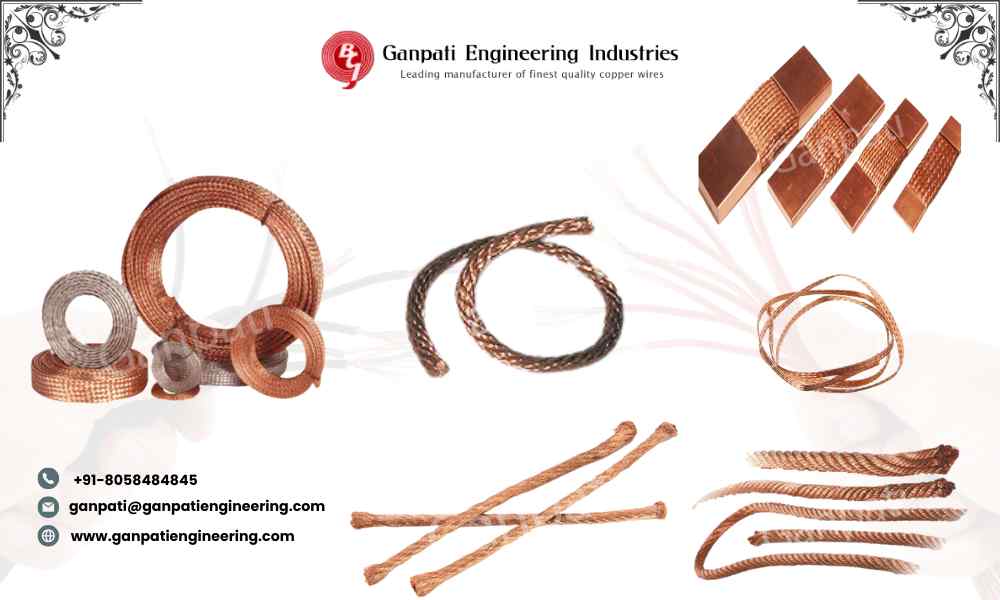In the world of electrical engineering, Braided Copper Wire stands out as a reliable and versatile solution for powering modern applications. This specialized wire, formed by weaving together numerous fine copper strands, delivers exceptional performance where flexibility and conductivity matter most. Whether you’re working on industrial setups or everyday electronics, understanding its core features opens up a range of possibilities.
Understanding the Basics of Braided Copper Wire
Braided Copper Wire is essentially a bundle of thin copper filaments intertwined in a crisscross pattern, much like a rope. This design sets it apart from solid or simple stranded wires, giving it superior bendability without sacrificing strength. Copper’s natural properties—high electrical conductivity and resistance to corrosion—make it the ideal base material.
Experts in materials science highlight how this braiding process creates a product that maintains tight contact between strands, ensuring efficient current flow even under stress. The result is a wire that’s not just functional but also built to last in demanding environments.
The Intricate Manufacturing Process
Creating top-tier Braided Copper Wire involves precision at every step, starting with high-purity copper rods. Manufacturers begin by drawing these rods—typically 8 mm in diameter—through diamond dies to form fine wires. This drawing happens in a controlled setup with lubricants and coolants to keep temperatures steady and shapes uniform.
Next comes annealing, where the wires heat up to around 1000°F in an electric furnace for a brief moment. This softens the metal, relieves internal stresses, and boosts ductility, making the wire tough yet pliable. After cooling, the strands undergo bunching or stranding on advanced machines, twisting them at specific lengths for smoothness.
The braiding itself uses specialized machines that feed tinned or bare wires into patterns—round, flat, or tubular. For added protection, a hot-dip tinning process coats the wires, enhancing solderability and longevity. Companies adhering to standards like ISO 9001:2015 ensure each batch meets rigorous quality checks, delivering wire that’s 99.99% pure and ready for real-world use.
Why Braided Copper Wire Excels: Key Advantages
The appeal of Braided Copper Wire lies in its unmatched combination of traits, as confirmed by electrical engineers worldwide. Here’s what makes it a go-to choice:
- Unrivaled Flexibility: It bends and twists effortlessly, ideal for tight spaces or moving parts, without cracking or losing efficiency.
- Superior Conductivity: The dense strand packing allows current to flow smoothly, minimizing energy loss even at high loads.
- Vibration Resistance: Perfect for machinery, it absorbs shocks and movements, extending equipment life.
- Excellent Shielding: Acts as a barrier against electromagnetic interference (EMI), keeping signals clean in sensitive electronics.
- Durability and Longevity: Tinned versions resist oxidation, ensuring reliable performance over the years.
- High Current Capacity: Handles heavy loads safely, making it suitable for power-hungry systems.
- Easy Installation: Lightweight and malleable, it simplifies wiring tasks for professionals.
These benefits stem from copper’s inherent qualities, amplified by the braiding technique, making it a smart pick for efficiency-focused projects.
Diverse Applications Across Industries
Braided Copper Wire shines in countless scenarios, powering everything from household gadgets to massive infrastructure. In the automotive sector, it connects batteries and starters, enduring constant vibrations. Power distribution systems use it for grounding and jumpers, where flexibility prevents failures from thermal shifts.
In renewable energy, solar inverters and wind turbines rely on their shielding to protect circuits. Marine applications benefit from its corrosion resistance in salty environments, while electronics like circuit boards use it for reliable interconnections. Even in railways and switchgear, it links components exposed to extreme conditions, proving its versatility time and again.
A Closer Look at Braided Copper Wire Connectors
Braided copper wire connectors take the wire’s strengths to the next level, serving as flexible links between busbars or terminals. These connectors bunch braided strands into custom shapes—flat for compact fits or round for broader coverage—with ends pressed or tinned for secure contacts.
They’re engineered for spots with expansion, contraction, or vibrations, like transformers, locomotives, and induction furnaces. Silver-plating options boost conductivity further, while the design absorbs movements in mining equipment or metro systems. With hot-dipped ends, they ensure flawless power transfer, reducing hotspots and enhancing safety.
Exploring Different Types of Braided Copper Wire
Variety ensures Braided Copper Wire fits any need:
- Round Braids: Compact and strong for shielding cables.
- Flat Braids: Space-saving for connectors and grounding straps.
- Tubular Braids: Expandable for sleeves over wires.
- Tinned Braids: Coated for extra protection in humid areas.
- Silver-Plated: Premium for ultra-high conductivity demands.
Each type builds on the core design, offering tailored solutions.
Selecting Trusted Braided Copper Wire Manufacturers
Reliable Braided Copper Wire Manufacturers prioritize purity, precision, and customization. Look for those using electrolytic-grade copper and modern braiding tech. Ganpati Engineering Industries, established in 1977 in Jaipur, exemplifies this with ROHS-compliant products from 99.99% pure rods. Their range includes custom braided copper wire connectors, backed by decades of expertise.
Ganpati Engineering Industries stands out for its end-to-end process, from rod drawing to final braiding, ensuring consistency. Partnering with such leaders guarantees wires that perform flawlessly.
Best Practices for Optimal Performance
To maximize Braided Copper Wire:
- Store in dry areas to preserve coatings.
- Use proper crimping tools for secure terminations.
- Pair with compatible lugs for strong bonds.
- Inspect periodically for wear in high-use spots.
- Opt for custom lengths to minimize joints.
These steps keep systems running smoothly.
Conclusion
Braided Copper Wire represents the pinnacle of flexible, high-performance electrical solutions, blending copper’s timeless strengths with innovative design. From manufacturing precision to wide-ranging applications and specialized braided copper wire connectors, it empowers industries with confidence and efficiency. Leading Braided Copper Wire Manufacturers like Ganpati Engineering Industries continue to elevate standards, ensuring this wire remains essential.
Embracing Braided Copper Wire means investing in reliability that lasts. Whether upgrading systems or starting new projects, its advantages deliver results you can trust.



